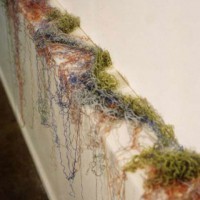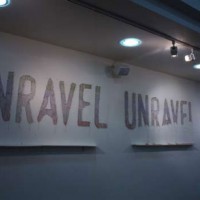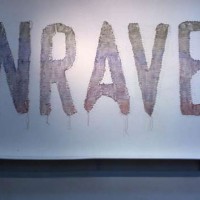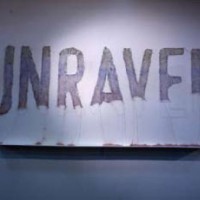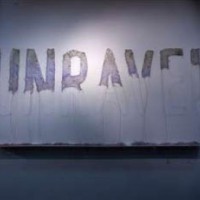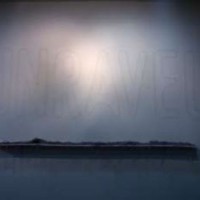Unravel
Materials:
Pins, acrylic yarn and pigment.
Concept:
‘Unravel’ is a typographic pictogram depicting its own meaning. Pictographs were the earliest forms of writing dating back to Egypt and Mesopotamia before 3000 B.C.
‘Unravel’ is hand knitted and dyed from discarded mill bobbins and pinned directly to the wall. The process evident in the stitches is a laborious/meditative function, its handmade nature revealed in the irregularities of its structure.
The term ‘ravel’ was used in dialect in the sixteen hundreds meaning to entangle or become entangled; the word unravel came into use in the seventeen hundreds believed to be from Du. Ravelen, tangle, fray out or unweave.1 ‘Unravel’ is delicately entwined onto thousands of steel pins on an otherwise blank wall, the ambiguity of the word keeps the meaning of the artwork suspended, hovering, it could mean: to undo twisted, knitted or woven threads; or that something has become undone (has unraveled); or to unwind (as in something wrapped around another object); or to investigate or solve a problem; or to begin to fail or collapse.
A certain wealth of the object is evident, inherent in the investment of time in its construction. The stitches count time and recount a long history of women’s handcrafts.
Knitting is a traditional handcraft often passed down from generation to generation and this hereditary is evident in ones technique. The Irish and the English hold their needles and wind their wool in a different way than European knitters. The artist Tricia Flanagan (b.1968) was taught to knit by her English born mother Heather Robinson (b.1945), who learnt from her Irish mother Martha Warren (b.1916) who in turn learnt from her Irish mother Mary Griffin (b.1894). In the 1830’s a state supported primary school system was introduced in Ireland with its main objective to teach the obligatory reading, writing, arithmetic, grammar and geography. Added to this was Needlecraft (for girls) and agriculture (for boys). The practical nature of knitting meant that it aided women greatly in hard times both as a way to clothe their families and as one of the few socially accepted forms by which women could make an income.
With the arrival of the industrial revolution and the introduction of the knitting machine gradually hand knitting became redundant as an economic necessity and was taken up as a leisurely pastime. The education system continued to teach handcrafts to women long after these techniques had become redundant in the home. Ciara McDonald’s view is that needlecrafts ‘remained in the curriculum not to be studied as subjects in their own right, but more as a measure of maintaining control over women. [ ] … Both the Government and the churches, through the Department of Education, wished to keep the place of women in the home.2
Unravel is re-knitted each time it is displayed. It was originally knitted during a month of long coach journeys exploring the central Australian outback. Someone once said to the artist: ‘Knitting is a process of rubbing sticks together to make a magic web of colour fall out.’ The weft of delicate text is grafted painstakingly onto tiny steel pins on a wall and it is then unravelled from below – the memory of the knitting remains visible in the crimp of the yarns collected on the ledges below.
Presented in a contemporary context, devoid of the functional aspect. The artist presents a metaphor for the evolving role of women – traditionally responsible for a family’s social and emotional well being – today women are working in professional careers while still maintaining care of home and family. The post-feminist woman splits her time, like each of the stitches, which together create a congruent whole. This work pays homage to women’s uniquely ability to manage these complex and overlaying networks. This is a work about the transitional period of re-evaluation and assimilation – towards women’s equality in society.
Exhibition:
Dunamaise Centre for the Arts, Foyer Gallery, Portlaiose, Ireland (2002)
‘Unravelations’, Schubertstrasse 36 Weimar, Germany (2002)
Watt Space Gallery, Newcastle, Australia (2000)
Publications:
FLANAGAN, P. (2000) Unravel. Art Almanac, February, p. 20.
Thanks:
Benjamin Flanagan
Endnotes:
1. HOAD, T.F. Ed. T. F. “ravel” The Concise Oxford Dictionary of English Etymology, 1996. Found at: Oxford Reference Online. The Concise Oxford dictionary of English etymology. Oxford ; New York, Oxford University Press. HOAD, T. F. & OXFORD REFERENCE ONLINE. Accessed 7 July 2009.
2. MCDONALD, C. (1996) INSTITUTIONS Needlework – A Stitch in Time. IN NAB, S. M. (Ed.) Thought Lines: an anthology of student research in the year 1995. Dublin (Ireland), National College of Aty and Design. P. 72.
